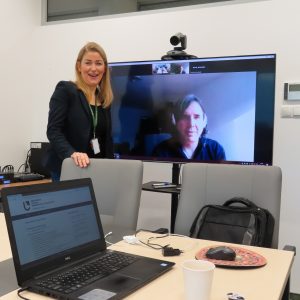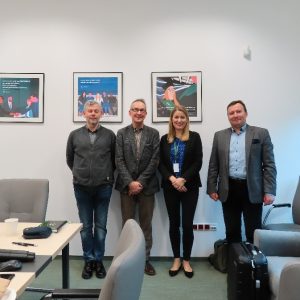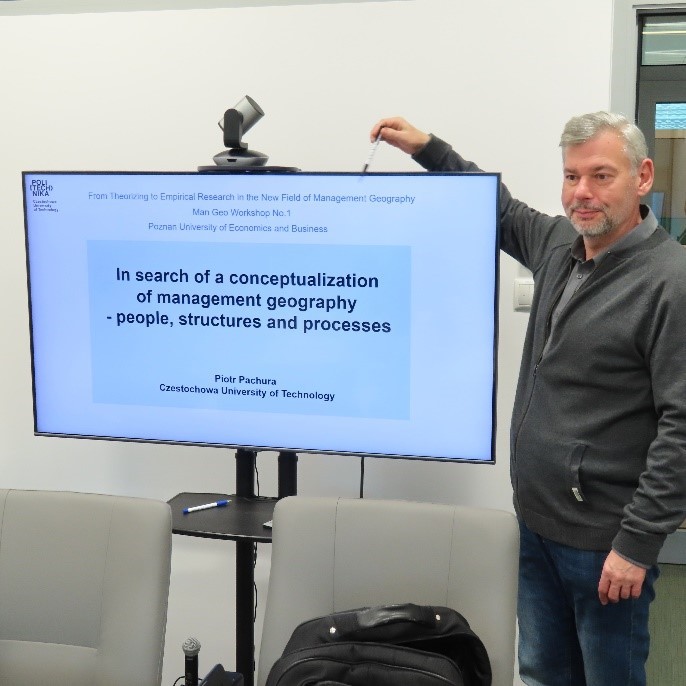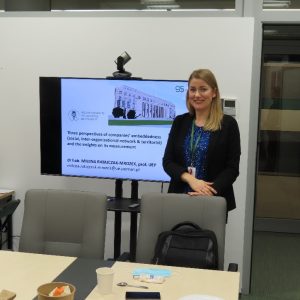Professor Dr. Milena Ratajczak-Mrozek organized with Dr. Rolf D. Schlunze a workshop entitled From Theorizing to Empirical Research in the New Field of Management Geography at Poznan University of Economics and Business, Poznan Poland at the CEUE Building, Room 2.10 (Towarowa 55, 61-896 Poznan Poland) from 11th to 12th February 2022.
Four members of ManGeo research group gathered for the workshop. The workshop was designed to prepare further research activities. We discussed about our common research theme Management Geography in purpose to design a joint research project. All research group members were eager to discuss how we can develop a unique approach based on ManGeo theory, spurred by innovative research methods finding empirical evidence for the importance of our geographical perspective on international management in an increasing complex world.
On Friday, 11 Feb. 2022, we started the workshop 2pm in the afternoon. The frist set was designed to discuss Theorizing managerial or organizational spaces. In this session we wished to discuss new theories for investigating managerial mobility, practices and decision-making in private and governmental organizations transforming spaces of international economy and management. Because of health problems Lech Suwala was not able to join us. However, Piotr Pachura (Czestochowa University of Technology) managed this session presenting his research insides entitled In search of a conceptualization of management geography – People, structures and processes.
Piotr approached the theme Management Geography from spatial science perspective to grasp the contextual aspects of management. He mentioned that he was developing similar ideas as Lech Suwala and shared those ideas with us. Citing on literature such as Lefebvre 1991, Foucault 1984, Beard and Price 2010, Roth and Sales 2017, Bourdieu 1996 and Soja 1996 he investigated how organizational culture effects organizational networks. He shared his review on previous research on proximity, Space, GPN/GVC and global practices with us. Piotr pinpointed on various mixed strands and lenses to approach the theme. He found that in International Business (IB) and Economic Geography (EG) spaces is perceived differently. His critiques were that meanwhile space is a key reference in Economic Geography management scholars perceive as minor aspect of businesses. He observed a trend to shift the focus on virtual aspects of IB studies. IB scholars view space not only as a distance but also as a materialization of power relations; and sometimes as lived experiences like the narratives on expatriated, international managers. For him the context of space is manifested by space, organization and management advancing to metaphorical understanding of space. Thus, Piotr was referring to organizational theory. He critiqued that the business environment often is perceived very blur and demands more fine tuning like applying sectoral or partitional aspects. Spaces of the organization such as internal and external, global space hosting corporate networks in the search of global sourcing, contextual space including culture, place and context and cyber-space were suggested as important aspect to be distinguished in future research projects. Initially, he aimed to build space model in accordance with common business models. Therefore, he referred to the classical work of Mintzberg (1973) who investigated the role of entrepreneurs as problem solvers, providers of interaction, and provision of information important for locational decision making. After presenting his theoretical developments he finally discussed his findings with us. Interviewing about 400 managers about their geographical perception and behavior with a huge list of up to 70 questions. To test his original space model including the list of questions, he conducted workshops with international managers and scholars. The evaluation provided a chance for improving but he preferred to replace the initial model with an organizational space model inspired by Sierpinski triangle (self-similar fractal) that reflect and incorporates sectorial or fractal aspects of businesses. Piotr briefly presented the model, which he defined as: ontologically complex structure of inter-subjective discontinuous spaces and the boundaries of organization consisting of: INTERNAL SPACES: (a1) micro-space; (a2) contextual space; (a3) physical, material space (co-space); VIRTUAL: (b) cyberspace; EXTERNAL SPACES: (c) physical (geographical) non-organizational space (d) space of organizational field (external contextual- institutional) – and – specific borders between spaces. Below is a schematic drawing relating to this space model.
In the second session entitled Providing empirical evidence, we wished to discuss management issues focusing on knowledge transfer and/or management as well as localizing and globalizing practices. Tomasz Dorożyński (University of Lodz) presented his research work entitled Do investment incentives matter in MNEs location choices? – Empirical Evidence from the Lodz Province. Tomasz sees locational aspects at the core of IB and also EG approaches. MNEs are looking at almost all countries and regions (which are politically and economically safe) to find optimal investment locations. He stated that theoretical and empirical studies have no clear answers about the criteria for choosing a location for FDI. There are numerous theoretical and empirical studies (see overview: Faeth, 2009; Kim, Aguilera, 2016; Nielsen, Asmussen, Weatherall, 2017) without any clear-cut answer about criteria for choosing location for FDI. The closest and most recognized theory was John H. Dunning’s eclectic theory of international production that brings together micro- and macroeconomic approaches. According to it, a firm’s decision to invest abroad is conditioned by enjoying three types of advantages (the so-called OLI paradigm): ownership advantages; internalization advantages; location advantages. Tomasz found that a component is missing that takes FDI decision-making incorporating a specific link to location. In his empirical research he observed that regions follow three basic strategies for acquiring FDI: 1.) Do nothing and expect that the free market will best identify the desired scale and industry structure of investment projects 2.) Try to attract them all, and 3.) Try to attract certain FDI categories, which fit long-term development plans and structural transformations in the economy. He observed changes in policies towards foreign investors which became more restrictive during the last decade in some countries and regions. Further, he observed a so-called Mitnahmeeffekt (free-rider effect / deadweight effect) of MNEs when carrying out FDI in the relationship with provincial and municipal administration in Poland. Consequently, he concluded that national, regional, and local authorities in all parts of the world offer investment incentives rather universally. Studies conducted so far in Poland and in other countries have revealed that their role in making location decisions was secondary, sometimes even marginal although it differed depending on circumstances, in which incentives were applied. For instance, where fundamental factors in competing localizations were similar, assistance offered by the authorities of the host country could be decisive (Dorożyński, 2020).
Milena Ratajczak-Mrozek (Poznan University of Economics and Business) presented her research findings entitled Three perspectives of companies’ embeddedness (social, inter-organizational network & territorial) and the insights on its measurement. Business networks were in the focus of Milena’s interest. Her research perspective is deriving from organizational theory and industrial marketing. She learnt about concepts such as MNE embeddedness but her empirical research carried out in Poland is more on SMEs. Further, she prefers to investigate the research objective firm embeddedness with qualitative approaches. First, Milena investigated domestic furniture industry in the Eastern part of Poland and found that they were exporting more to Denmark than to Germany. She found that location in real space indeed still matters. To explain about the decision making of SMEs she applied various theoretical approaches also including the effectuation theory. Her concern is that in the embeddedness theory the location and the relationships are measured so differently. She found that a lack of terminology and consistency exists. Further, she critiqued that many research are over interpreting the work of Granovetter who was concerned about personal relations; and, Polany who focused more on structural and relational aspects. A mix of these two different approaches results in work such as Zukin and DiMaggior (1990) coming up with four different types of embeddedness. Instead of building more categories Milena finds it more worthwhile to investigate the dual embeddedness in interorganizational relations. Here, the critique is that the interorganizational network embeddedness in the literature does not show any coherency at all. She suggested that the key role, relative strength, and identities of connections should be in concern of embeddedness analysis. She referred to Halinen and Toernross (1998, p.188) who distinguished temporal, spatial, social political, market and technological aspects of embeddedness by assuming vertical and horizontal dimensions. Further, Milena as an international marketing expert prefers to look at territorial embeddedness. Local embeddedness adapting to business practices and principles that can be found locations is also perceived as a useful concept by her. However, Milena comes up in her work with a) social embeddedness, b) interorganizational embeddedness, and c) territorial embeddedness for her research. The degree of embeddedness she likes to assess by stages of adaptation, mutuality, and trust development in respect to the three most important customers of a firm.
On Saturday, 12. Feb. 2022 we had the final session hold in hybrid form. One speaker joined us by Zoom. Our guest speaker, Michael Kronenwett (Kronenwett & Adolphs UG), provided a workshop-like exercise introducing MyNetworkmap, an online tool for social network analysis. Melina and other participants were fascinated by the design of the innovative research tool. MyNetworkmap offers functions and options enabling the researcher to visualize individual manager’s network showing the strength of relations and the connectivity of the alteri. The program produces data in the background that describe the network density. This data can be used for statistical analysis. The online questionnaire can be combined with various kinds of questions investigating further characteristics and perceptions of the interviewee.
Then after Rolf D. Schlunze (Heinrich-Heine Univ./Ritsumeikan University) presented his preliminary findings entitled Shaping spaces of innovation communities – Analyzing the role of promoters in German Japanese innovation networks. He introduced his model including the theory of proximity and knowledge networks that applies also to the context of innovation in the intercultural contexts. His ongoing research will provide empirical evidence nurturing a theory that explains formation of cross-cultural innovation communities from a management geography perspective. A mixed method was applied to heighten the validity by triangulation; and to acquire a deeper understanding of the phenomenon. First results from participative observation and an online questionnaire showed what can be done in the field of ManGeo with the software Vennmaker.com and online tools as MyNetworkmap.

Michael presents online how to survey, visualize and analyze social networks with his innovative software, the online questionnaire MyNetworkmap.com
Finally, all participants considered steps and options of joint research project by the participating ManGeo Research Group members. Milena sees the potential to use MyNetworkmap for getting data creating a better typology distinguishing predictive and non-predictive decision-making behavior of SMEs in the line of the effectuation theory. Rolf suggested that networks of managers at the level of MNE and SME can be investigated to evaluate the degree of internal and external embeddedness and, accordingly, the implementation of corporate strategies. Tomasz suggested that managers’ interaction in the external business environment such as governmental officers in charge of spurring the local economy could be investigated more in detail and help to discover successful investment promotion practices as well. Piotr’s theoretical discussion let us assume that we could take the opportunity to survey the ontologically complex structure of inter-subjective discontinuous spaces by investigating managerial practices that constitute a boundary between internal and external corporate spaces but also bridge inter-organizational boundaries.
 |
 |
|
Participants on the spot: Piotr, Rolf, Milena und Tomasz |
Piotr presenting a conceptualization of management geography |
 |
 |
|
Milena presenting about MNE embeddedness measurement |
Tomasz presents about investment incentives for MNEs and their locational choices |
